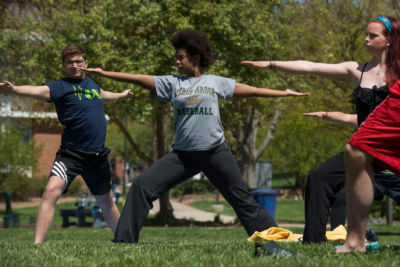By: Avinash Patwardhan MD, MS, Adjunct Assistant Professor, Global and Community Health
“Yoga is essentially a practice for your soul, working through the medium of your body.” – Tara Fraser
Yoga is immensely popular around the world and in the United States, and its popularity is continuing to grow. Yoga offers many powerful well-being benefits, and also many diverse ways to practice. Here are key highlights of how yoga can strengthen your well-being, and how to choose the best yoga practice for your particular needs.
By practicing yoga, research shows you can experience well-being benefits that include:
- Physical fitness: Practicing yoga can improve your strength, balance, and flexibility, relieve back pain, and improve heart health.
- Mental health: Yoga can help you develop a sharper brain and an improved mood, helping you concentrate, relieve stress, and feel calm.
- Spiritual inspiration: When you practice yoga, you can experience spiritual enlightenment to help you cultivate joy, peace, and contentment.
In the maze of about 7,000 registered yoga schools and more than 100,000 registered yoga teachers in the United States, it is not easy to find out or decide how best to practice yoga. The decision making can become a challenge, and you may find yourself choosing a yoga style, brand, studio, or teacher based on friends’ recommendations alone.
How to Choose the Best Yoga Practice for You
First, understand that yoga is just one part of an overall fitness plan. Fitness is multidimensional. It includes cardiorespiratory, muscular fitness, joint flexibility, and overall healthy body composition. Evidence suggests that broadly, excluding helping joint flexibility, yoga’s ability to contribute to physical fitness is nuanced and may be marginal. It appears to offer more because of “healthy user bias”. For example, if you run four miles and also engage in yoga practice in parallel, the causality of physical fitness gets masked and misattributed. Therefore, if you are not engaged in other physical exercises such as walking, running, swimming, etc. then you should not rely only on yoga, particularly the postural part of yoga, as a standalone exercise for physical fitness.
On the other hand, if you are seeking help from yoga for stress management or issues like anxiety or depression (as a supportive modality), then you may want to focus on breathing exercises and meditation, while foregoing postural part of yoga without much consternation (provided you do other physical fitness exercises).
You should also be aware that simple deep long breathing and simple mindfulness meditation can suffice for your needs, and other esoteric breathing or meditational techniques can be just overkill. Lastly, if you are seeking yoga for spiritual pursuits, then none of the three major pillars of yoga – postures, breathing techniques, or meditation – might provide much of a return on investment. In that case, you might be better off by reading and understanding the ancient yoga-related scriptures such as the Upanishad and the Bhagavad Gita.
The role of gurus, mentors, and teachers in yoga is like that of baby walkers or floatation devices. At some point they must be left behind, and the sooner, the better. You cannot, should not, or would not want to walk, swim, or do yoga by proxy forever. Feel free to pursue your own best practices for yoga, with confidence.
Yoga can be a useful practice for the well-being of all people. Enjoy discovering the ways that yoga can most benefit you.
Additional Resources
Mason 360 lists upcoming yoga events at Mason.
Yoga Journal features a wealth of yoga information at Yoga Journal.com.
Learn more about how yoga works at Medical News Today.com.
Write one of these Thriving Together Series features! We’re looking for contributions on all topics related to well-being. Read other Thriving Together Series articles here and contact us at cwb@gmu.edu for guidelines. Thank you for helping our Mason community thrive together online!






















